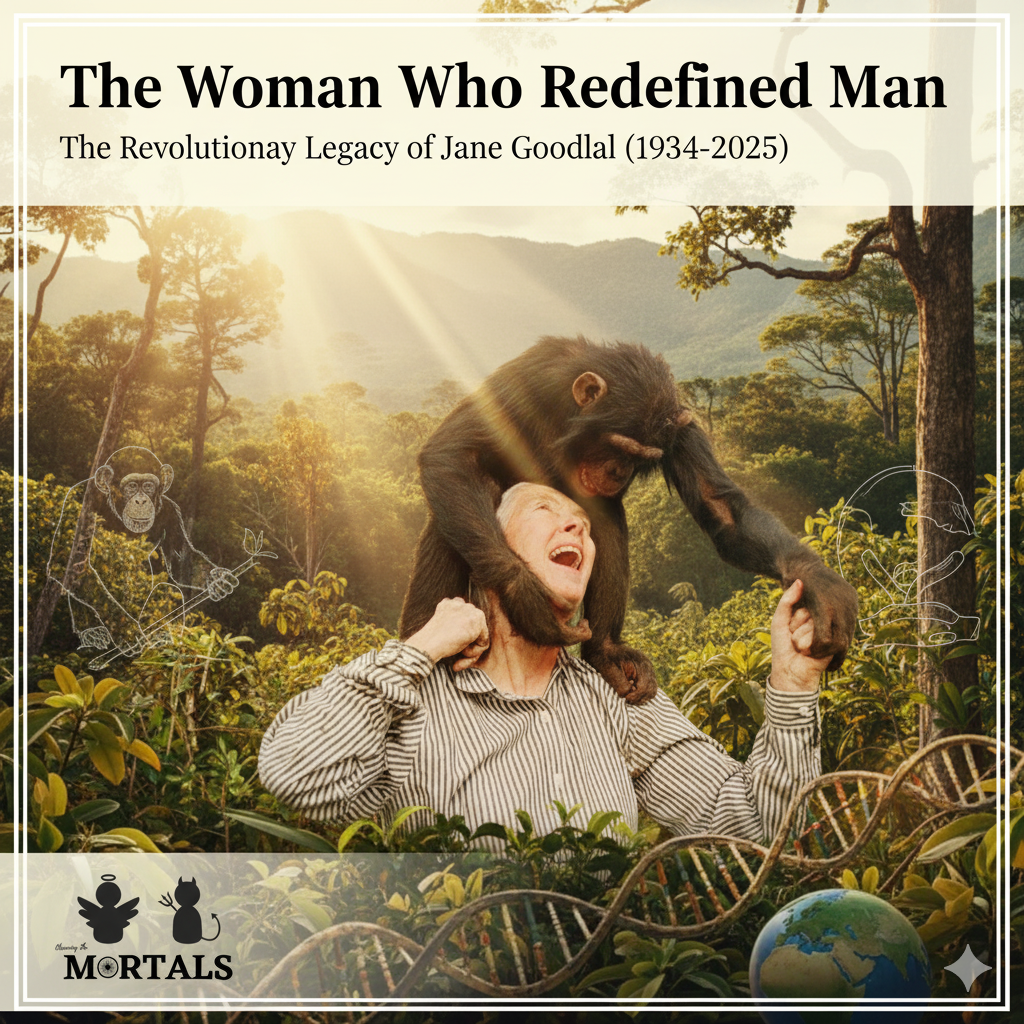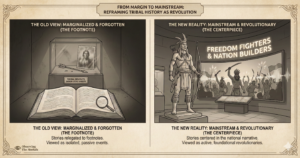The world of science has lost one of its most iconic and beloved figures. Dr. Jane Goodall, the primatologist whose groundbreaking work with wild chimpanzees shattered our understanding of the animal kingdom and our own place within it, has passed away at the age of 91. Her story began with a young Englishwoman, with no formal scientific degree, stepping into the forests of Gombe, Tanzania, armed with little more than binoculars and boundless patience. It ends with the legacy of a global icon who did more than just study our closest living relatives; she forced us to redefine what it means to be human and inspired a worldwide movement for conservation. This is not an obituary, but a look at her revolutionary contributions.
The Information Box
Syllabus Connection:
- Paper 1: Chapter 1.5 (Primate Behaviour), Chapter 1.4 (Human Evolution), Chapter 1.3 (Scope of Physical Anthropology)
Key Concepts/Tags:
- Jane Goodall, Primatology, Chimpanzees, Tool Use, Primate Behavior, Conservation, Participant Observation
The Setting: Who, What, Where?
This case study is centered on the life’s work of Dr. Jane Goodall, the world’s foremost authority on chimpanzees. Her story is inseparable from her research site: the Gombe Stream National Park in Tanzania, where she began her groundbreaking study of wild chimpanzee social and family life in 1960. Her method was radical for its time: instead of detached observation from a distance, she practiced a form of immersive, long-term participant-observation, gradually gaining the trust of the chimpanzee community.
The Core Argument: Why Her Work Was a Revolution
Jane Goodall’s discoveries fundamentally altered the course of physical anthropology and primatology.
- Shattering the “Man the Toolmaker” Myth: Goodall’s most famous and explosive discovery was observing a chimpanzee she had named David Greybeard carefully stripping leaves from a twig to use it as a tool to “fish” for termites in a mound. Until that moment, the Western scientific definition of “human” rested on the idea that only humans made and used tools. Upon hearing the news, Goodall’s mentor, the great paleoanthropologist Louis Leakey, sent a historic telegram: “Now we must redefine ‘tool,’ redefine ‘Man,’ or accept chimpanzees as humans.”
- Revealing the Inner Lives of Primates: Before Goodall, animal behavior was studied with a cold, clinical detachment. Animals were assigned numbers. Goodall’s approach was revolutionary. She insisted on giving her chimpanzees names (like Flo, Fifi, and Frodo) and documented their distinct personalities, complex social bonds, and deep emotional lives. She was the first to record, in detail, their capacity for joy, altruism, grief, and, as she later discovered, brutal, organized warfare between rival communities. She proved that the line between human and non-human animal emotions was not a sharp wall, but a blurry, permeable membrane.
- From Scientist to Global Advocate: Goodall created a new model for what a scientist could be. She successfully transitioned from a reclusive field researcher into one of the most powerful and recognizable voices for global conservation. Through her countless books, National Geographic documentaries, and the establishment of the Jane Goodall Institute and its “Roots & Shoots” program, she used her scientific authority and personal charisma to inspire millions of people to take action for environmental protection and animal welfare.
The Anthropologist’s Gaze: A Critical Perspective
Even a figure as revered as Goodall has been part of the discipline’s critical self-reflection.
- The “Anthropomorphism” Debate: In her early career, Goodall’s methods were heavily criticized by the scientific establishment. Her practice of giving names to chimps and interpreting their behavior in terms of human-like emotions was dismissed as unscientific “anthropomorphism” (projecting human qualities onto animals). Today, as our understanding of ape cognition and emotion has grown, her empathetic approach is largely seen as having been ahead of its time.
- The Impact of Provisioning: To facilitate her research, Goodall’s early work involved setting up a feeding station with bananas to attract the chimps for closer observation. This practice of provisioning, while common then, is now known to significantly alter natural primate behavior, often increasing aggression and conflict. This is a methodological critique that is now a key part of the history of primatology.
- The “Lone Woman” Narrative: The popular image of Goodall as the “lone woman in the jungle” is iconic. However, a critical perspective would emphasize that this narrative, while true in its essence, can sometimes obscure the vital, decades-long contributions of her team of local Tanzanian researchers, trackers, and staff. Their essential role was a key factor in the long-term success and continuity of the Gombe project.
The Exam Angle: How to Use This in Your Mains Answer
- Types of Questions Where It can be Used:
- “Discuss the socio-psychological traits of the primates.”
- “How has the study of primate behavior contributed to our understanding of human evolution?”
- “Critically evaluate the different methods used in the study of primate behavior.”
- Model Integration:
- On Primate Behavior: “The study of primate behavior is crucial for understanding the origins of human society. Jane Goodall’s groundbreaking long-term research in Gombe revolutionized the field by demonstrating that chimpanzees, our closest living relatives, exhibit complex social lives, distinct personalities, and emotional depth.”
- On Tool Use: “The concept of ‘Man the Toolmaker’ was fundamentally challenged by the work of primatologist Jane Goodall. Her observation of chimpanzees modifying twigs to ‘fish’ for termites proved that tool-use and tool-making are not exclusively human traits, forcing a re-evaluation of our evolutionary uniqueness.”
- For a critical view (Methodology): “While Jane Goodall’s immersive fieldwork was revolutionary, her early methods, such as naming subjects and using feeding stations (provisioning), were initially criticized by the scientific community for ‘anthropomorphism’ and for potentially altering natural behavior. This debate was crucial in shaping the modern ethical and methodological standards of primatology.”
Observer’s Take
Jane Goodall’s passing marks the end of an era, but her legacy is immortal. She was more than just a scientist; she was a storyteller who fundamentally changed our relationship with the natural world. Her great gift was to look at our closest living relatives and see not “specimens” or “subjects,” but individuals with names, families, and lives that mattered. In doing so, she held up a mirror to humanity and forced us to reconsider our own arrogant place at the center of the universe. Her legacy is written not just in scientific papers, but in the profound sense of empathy, connection, and responsibility she inspired in millions. She went into the forest to understand chimpanzees and ended up teaching humanity about itself.





